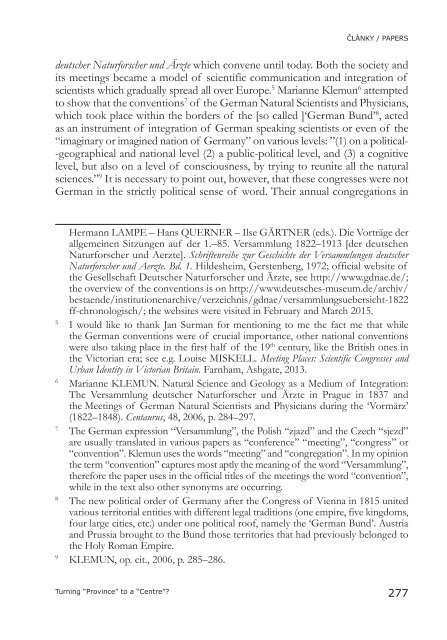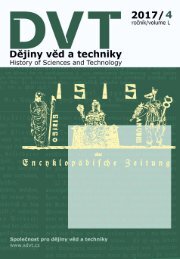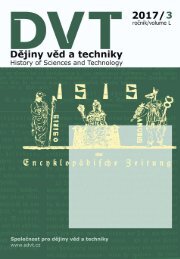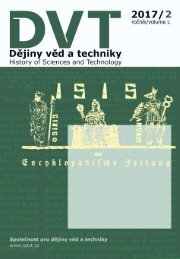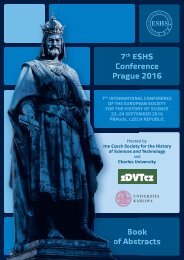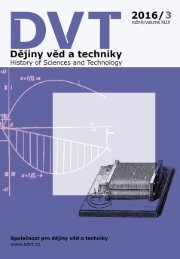Dějiny věd a techniky 2015, 4
Číslo je věnováno 7. mezinárodní konferenci Evropské společnosti pro dějiny vědy, která se konala 22.–24. září 2016 v Praze.
Číslo je věnováno 7. mezinárodní konferenci Evropské společnosti pro dějiny vědy, která se konala 22.–24. září 2016 v Praze.
Create successful ePaper yourself
Turn your PDF publications into a flip-book with our unique Google optimized e-Paper software.
ČLÁNKY / PAPERS<br />
deutscher Naturforscher und Ärzte which convene until today. Both the society and<br />
its meetings became a model of scientific communication and integration of<br />
scientists which gradually spread all over Europe. Marianne Klemun attempted<br />
to show that the conventions of the German Natural Scientists and Physicians,<br />
which took place within the borders of the [so called ]‘German Bund’ , acted<br />
as an instrument of integration of German speaking scientists or even of the<br />
“imaginary or imagined nation of Germany” on various levels: ”(1) on a political-<br />
-geographical and national level (2) a public-political level, and (3) a cognitive<br />
level, but also on a level of consciousness, by trying to reunite all the natural<br />
sciences.” It is necessary to point out, however, that these congresses were not<br />
German in the strictly political sense of word. Their annual congregations in<br />
Hermann LAMPE – Hans QUERNER – Ilse GÄRTNER (eds.). Die Vorträge der<br />
allgemeinen Sitzungen auf der 1.–85. Versammlung 1822–1913 [der deutschen<br />
Naturforscher und Aerzte]. Schriftenreihe zur Geschichte der Versammlungen deutscher<br />
Naturforscher und Aerzte. Bd. 1. Hildesheim, Gerstenberg, 1972; official website of<br />
the Gesellschaft Deutscher Naturforscher und Ärzte, see http://www.gdnae.de/;<br />
the overview of the conventions is on http://www.deutsches-museum.de/archiv/<br />
bestaende/institutionenarchive/verzeichnis/gdnae/versammlungsuebersicht-1822<br />
ff-chronologisch/; the websites were visited in February and March <strong>2015</strong>.<br />
<br />
I would like to thank Jan Surman for mentioning to me the fact me that while<br />
the German conventions were of crucial importance, other national conventions<br />
were also taking place in the first half of the 19 th century, like the British ones in<br />
the Victorian era; see e.g. Louise MISKELL. Meeting Places: Scientific Congresses and<br />
Urban Identity in Victorian Britain. Farnham, Ashgate, 2013.<br />
<br />
Marianne KLEMUN. Natural Science and Geology as a Medium of Integration:<br />
The Versammlung deutscher Naturforscher und Ärzte in Prague in 1837 and<br />
the Meetings of German Natural Scientists and Physicians during the ‘Vormärz’<br />
(1822–1848). Centaurus, 48, 2006, p. 284–297.<br />
<br />
The German expression “Versammlung”, the Polish “zjazd” and the Czech “sjezd”<br />
are usually translated in various papers as “conference” “meeting”, “congress” or<br />
“convention”. Klemun uses the words “meeting” and “congregation”. In my opinion<br />
the term “convention” captures most aptly the meaning of the word “Versammlung”,<br />
therefore the paper uses in the official titles of the meetings the word “convention”,<br />
while in the text also other synonyms are occurring.<br />
<br />
The new political order of Germany after the Congress of Vienna in 1815 united<br />
various territorial entities with different legal traditions (one empire, five kingdoms,<br />
four large cities, etc.) under one political roof, namely the ‘German Bund’. Austria<br />
and Prussia brought to the Bund those territories that had previously belonged to<br />
the Holy Roman Empire.<br />
<br />
KLEMUN, op. cit., 2006, p. 285–286.<br />
Turning “Province” to a “Centre”?<br />
277


